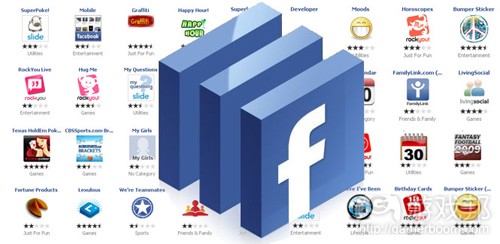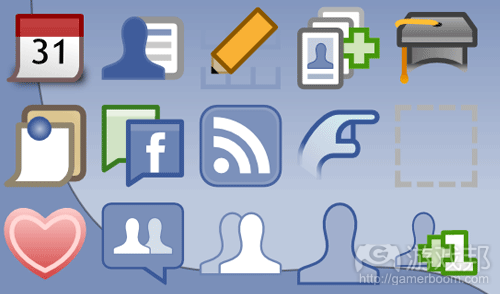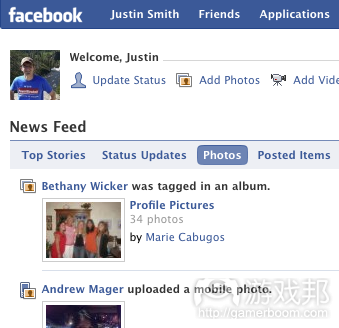归纳打造完美Facebook应用的设计准则
游戏邦注:本文发稿于2008年3月底,所涉时间、事件和数据均以当时为准。
Facebook是当下互联网上最大和增长速度最快的社交网络站点。更令人振奋的是,2007年5月底Facebook发布开发者平台,任何用户都可以使用并通过“安装”在用户账户中的应用与所有用户互动。当用户将应用安装至账户中,相当于承认该应用可以查看他们的姓名、头像、爱好、活跃度、年龄和好友等个人信息。应用可以在获取此类信息后,依此加强用户的Facebook体验。用户也可以使用Facebook本身还不具备的创新方式与其他用户互动。目前已有数千个开发者制作应用投放到Facebook上,但获得逾数十万Facebook用户青睐的应用只有少数。现在,你也有机会制作应用来吸引Facebook上的用户。
本篇指导内容包括制作Facebook应用所需考虑的关键想法和战略。这些想法和战略会让应用的人气指数上升十倍。总体想法是向Facebook用户推荐并怂恿其使用你的应用,随后在好友间共享应用。为达成上述目标,你需要让应用不断给用户带来充满乐趣的体验。需要记住的关键要素是用户。Facebook是个由用户构建而成的社交网络站点。当你与这些用户互动时,不可以任何方式烦扰、迷惑或欺骗他们。他们有决定应用好坏的权利,你必须考虑到这一点。(游戏邦注:作者首先提及用户而不是开发者,这也显示出用户的重要性。)
下文将向你介绍实施得当便可快速获得Facebook用户关注的战略和想法。这些战略和想法背后潜藏的三大主要方案会将用户带进你的应用中,诱惑他们使用你的应用并与好友分享应用。以下是能够产生效果的三个核心概念:应用简单;激发好奇心;礼貌请求。
应用简单
这是应用开发的基本准则,许多开发者有很棒的想法,但结果却不甚理想,因为他们的应用令人琢磨不透或过于复杂。对Facebook应用来说,第一印象很重要。许多用户对新应用特别好奇,也很愿意尝试。如果他们在应用安装使用的10秒钟内感到困惑,很可能会移除应用而且不再安装。即便将来你做出改变,也已经失去数千名潜在用户,这仅仅是因为应用最初过于复杂所致。
最初应当放缓游戏节奏,向用户展示小部分游戏功能,慢慢培养他们的使用习惯。利用FBML(游戏邦注:全称Facebook Markup Language,装饰用户Facebook页面的工具)让应用看上去像是Facebook的一部分。既然用户离不开Facebook,那么就无需改变应用的外观和感觉。适当向用户介绍应用,让其外观和感觉与Facebook保持一致。以下是具体做法:
当用户首次安装应用时,他们会重新指向你设置的某个URL,这称为“Post-Add URL”。你可以通过“安装选项”下的应用设置来设定。需要注意的是,如果你想要允许应用被Facebook上其他用户所添加,只能修改“安装选项”。为应用基本功能制作某些类型的教程或可轻易完成的任务。用户随后会不断学习到新功能。开始时只需要指出应用中最重要的内容,你需要确保用户知道应用的作用以及如何使用。精心编写文件阐述应用的每个功能,回答用户提出的所有问题。如果用户看完应用的介绍,就有可能不会移除应用。但这并不意味着他们会使用这款应用。保持应用用户活跃度的战略将在下文中具体分析和解释。
Facebook开发商平台有自己的FBML。使用FBML可添加与Facebook相契合的菜单、按键和链接。现在对许多新用户而言,Facebook相当复杂,如此多的功能很容易让人感到不知所措。因而当用户最终习惯使用Facebook后,没必要通过新应用让他们再次感到困惑。解决这道障碍的首个步骤便是发布外观和感觉类似Facebook的应用。你可以使用FBML制作“邀请朋友”按键、菜单栏、次级菜单栏、“分享”按键以及更多Facebook已经采用的功能。现有用户及新用户很熟悉这些按键和设计,他们知道如何操作。这样可以简化应用,是首个制作完美Facebook应用的步骤。
激发好奇心
若开发者瞄准Facebook用户推出应用,那么切记不要将应用投放该平台后便置之不理。和所有关系一样,良好关系都需要双方共同维护。如果应用停滞不前,那么用户便不会倾心于此。用户会安装这些应用,但很快就会忽略它们。开发商应尽可能带给用户令人兴奋的元素。用户都有好奇心;开发商需要满足他们的需求。用户都有自我意识;开发商需不时称赞用户在应用中的操作行为。若他们感到厌烦;那么开发商就应该添加令他们着迷的元素。这些都是基本观点,交织在一起,开发商就能够创造一款高度活跃的强大应用。用户使用应用的活跃度越高,开发商所获得的反馈就越多,这反过来会告知开发商应如何完善应用,以及获得新用户。这就像个社交网络,网络中的用户扮演主导角色,他们开展社交活动。如果开发商提供社交内容,或社交途径,用户就会和好友分享。推广应用的话题在核心理念(游戏邦注:礼貌请求)中得到进一步延伸。目前我们有系列方法能够留给用户猜测空间,维持用户在应用中的活跃度。
留给用户猜测空间的最普遍方式就是融入积分系统。积分系统应用广泛,主要有两大组成部分:用户获得积分方式和用户使用积分方式。开发商可以根据用户应用内行为(游戏邦注:如邀请好友、同好友互动、发表评论和提出建议)给予相应奖励,也可提供解决问题(例如,谜题、游戏、谜语和琐事)的用户积分奖励。用户获得积分后,开发者首先要提高用户获得积分的欲望。积分可以是某种能让用户“购买”应用新功能、道具或其他用户活动的货币。积分能够决定等级。等级面向活跃用户解锁新功能。活跃用户能够接触到新功能或新道具,将不合格用户排除在外,告知他们只有获得足够积分方能解锁新道具或新功能。开发商需谨记自己已同用户建立某种联系,同时用户维持关系意识至关重要。通过积分系统维持用户活跃性能够保持用户好奇心和沉浸性。
另一保持用户活跃度的方法是将应用变成实用工具。这种应用的实用性或许超过创新性。若应用扮演的是工具角色,开发商依然能够保持用户好奇心、活跃度和应用趣味性。再次重申这是个社交网络,创造工具互动性能够促进用户互相交流。这种交流方式或直接,或间接。直接交流方式包括用户分享和用户评价。用户互相分享观点,或评价其他用户的内容和可能性,这些都是建设性意见。间接方式包括用户对比和用户提交内容。让用户获悉他/她如何同其他用户进行比较。创造玩家间的兼容性,这样用户才能知晓哪些用户资源最丰富,与自己最相似。如果开发商没有足够时间在应用中添加新功能,那么就探索途径让用户提交内容(游戏邦注:内容可以采用新话题、新观念或新产品形式)。开发者可在用户提交内容环节融入审核过程,方可避免海量的提交内容。或者进一步来讲,借助社交网络,让玩家就内容进行投票。票数多的内容将获得采用。之前提到的积分系统不仅在创新应用中效果极其显著,在实用应用中,其成效也不容轻视。这大大增加Facebook应用的整体价值。随着用户活跃度不断提高,应用便能够创建牢固运作基础。开发者没有理由停止完善应用,切记保持用户好奇心。
礼貌邀请
迄今为止你已经向用户推广了许多成功的应用,他们也乐于使用这些应用,但是为何你的用户却仍未增加?简单地来说,你可以让现存玩家帮你宣传应用,因为我已经看过很多类似的例子,但是我现在想要从一个更广泛的角度解释这个问题。可以说“邀请朋友参加”算是病毒式传播中最普遍的一种途径,同时我也认为这是一种较为强制性的功能。所以我们没有理由不抓住这个机会。 使用FBML(Facebook Markup Language)这一功能只需要短短的几行代码,很简单。所以如果你的应用中还没添加这个功能,那就赶紧抓紧行动吧。
让用户邀请朋友共同参与这一功能最大的弊端便是,用户可能会因此感到厌烦。如果用户在执行每一步操作后都被迫向好友提出邀请,他们肯定会对此感到厌烦甚至不再光顾这款应用。如今的Facebook平台一天只允许用户邀请20名以内的好友。但是别担心,还有很多好方法能够让你邀请用户主动与好友分享你的应用,而且不会让他们感到唐突和不快。我认为Facebook告示便是是一个有效的方法。当用户在应用中与其它用户进行互动时,便可以通过告示告知对方,例如你在打听一名用户的消息,系统便会告知对方这一情况,然后让他们也来关注你。而如果对方并未安装该应用,他们有可能因该告示而产生安装意愿以便刺探你的消息。这样做将有助于应用吸引更多新用户。因为现在Facebook并未限制每一名用户发送的告示数量,所以开发者可以尽可能并合理地利用这一功能。但任何不受限制的事物都有陷入滥用的局面,所以你不可逾越这道界限,必须合理地利用这一功能,因为它不仅能够带来新用户,同时也有助于挽留更多活跃用户。
另外一种能够提高应用关注度的方法便是mini-feeds和news feed功能。你可以通过FBML,在用户的mini-feed中刊登一些信息。这边有两个需要注意的关键问题。首先,如果你在用户的mini-feed界面发布消息时,其他可浏览这些用户个人资料的用户也可以看到这类消息。假始你的应用在mini-feed露脸的次数较多,也就有可能获得理想的曝光率。mini-feed中通常会包含一些文本,链接和图像内容。巧用这些文本,链接和图像内容,你可以更好地向用户展示应用内容,使其从海量的消息条目中脱颖而出。如果他们主动点击这些内容,那便说明你已经成功吸引其注意力了。mini-feeds的另一个妙用就是news feed。用户在登录Facebook页面时,便能立刻看到news feed所显示的信息,而这些消息也包含好友的mini-feeds相关内容。使用这一功能,有利于用户在其他好友的news feed中看到mini-feeds的内容。你可以通过多种方式执行这种操作,但有两个最管用的做法就是重复和批量动作。重复是指用户频频使用某款应用,而该应用也会因此在其mini-feeds发布相似的消息;批量动作是指当无数用户都在执行相同的操作时,这些用户总数将会显示在news feed界面中。无论你如何将内容打入用户的news feed,都无法绕过mini-feed这一重要环节。
告示和mini-feed功能都是帮助你提高用户基础的重要手段,而且它们也都可以称得上是一种较委婉,而且礼貌的邀请方式。如果能让用户喜欢上你的应用,并成为活跃用户,那便不用担心了,因为这些用户没有理由不向好友推荐这么一款好应用。就像前文提到的那样,不要乞求用户邀请好友,而要体面地让他们与好友分享内容。告示和mini-feed可以说是一种礼貌且保守的好方法,能够推动用户通过口碑传播,提高应用的知名度。
总结
如果你已经成功开发了一款优秀的应用,那下一步就需要思考如何从中获利。可以说Google Adsense是最有效且最简单的盈利方法,但是你必须清楚在哪里投放广告才最适合。同时也要注意,不要在应用中植入超负荷的广告。另外也可以考虑向用户推广一些可与应用本身绑定在一起的产品或服务。如果你能够针对应用内容,使用一些用户感兴趣的推荐识别代码,那便说明你已经有了很大的胜算。而如果你的应用已经取得了一定的成功,你便能够将应用中的部分空间出售给一些较有发展潜力的应用开发者,让他们交叉推广应用。这些都是一些常规而简单的盈利解决方案,或许将让你从Facebook中谋取更大利益。如果幸运地话,你的应用也可能因为虏获了大量用户,而引来有意买下它的大型公司。
对于很多应用开发者来说,Facebook还是一个新的领域。利用Facebook这个巨大的平台,你能够尽情向用户展示自己的想法。但是也因为它的无限制性,导致了许多滥用空间的行为相继出现。控制好应用可能产生的行为,是打造一款成功的Facebook应用的关键所在。你必须牢记,用户是Facebook平台生存的基石,所以必须时刻将用户摆在第一位。如果你能够为用户创造一款能够取悦他们的应用,那么他们反过来也会为你带来不可估量的商机。这便是如何在Facebook上推出一款出色应用的重要法则。(本文为游戏邦/gamerboom.com编译,如需转载请联系:游戏邦)
How To Design The Perfect Facebook Application For The Users And You
Facebook is one of the largest and fastest growing social networking sites on the web. They just opened registration to anyone in September of 2006 and have increased their user base to over 40 million users. What’s even more exciting is at the end of May 2007 Facebook launched their developers platform allowing any user to access and interact with their entire user base through an application which can be “installed” to a user’s account. When a user installs an application to their account it grants the application access to their information such as name, profile image, interests, activities, age, friends and more. The application can then take the information and use it to enhance the user’s experience on Facebook. Users can do this by using the app to interact with other users in new ways not already available on Facebook. Already thousands of developers have created applications that have been added to Facebook, but only a few have had the success of reaching out to hundreds of thousands of Facebook’s 40 million plus users. Now is your chance to create an application (app for short) that will attract thousands of Facebook users.
This guide will include key ideas and strategies to consider when creating a Facebook Application. These ideas and strategies will help increase your app’s popularity ten-fold. The whole idea is to introduce and entice Facebook users to an app that you’ve created, and then share it with their friends. In doing so you want to make your app an enjoyable experience and a continuing one for the users. The key thing to remember is the users. Facebook is a social networking site, built and managed by the users. When you are interacting with these users you do not want to annoy, confuse or deceive them in anyway. They have the power to determine how great your app is and you must respect that. (Did you notice how I put the users first before you in the title?)
In the following context you will be introduced to strategies and ideas that, when executed appropriately, will produce fast results, winning Facebook users over. The three main goals behind these strategies and ideas will introduce users to your app, entice them to use your app, and get users to share your app. These are the three core concepts that will do just that: make it simple, keep them guessing, and ask politely.
Make It Simple.
As fundamental as this may sound, many developers have great ideas, but execute poorly because their application was confusing or too overwhelming. First impressions are huge when it comes to Facebook applications. Many users (especially in these early stages) are curious about new applications and are willing to give it a chance.
If within the first 10 seconds after the application is installed and they are confused, more than likely they’ll remove that application and never install it again.
Even if you change it in the future you’ve already lost the attention of thousands of potential users just because you didn’t initially make it simple to use. Start slow, introduce users to a small portion of the features, and walk them through using the application on initial install. Use FBML to make your application look like a part of Facebook. The users never left Facebook, so why change the look and feel? Give the users a proper introduction to your app and keep it consistent with the look and feel of Facebook. And here’s just how you can do this:
When a user first installs your application they are redirected to a specific URL that you set. This URL is called the Post-Add URL. You can set this in the settings of the applications under Installation Options. (Note: You can only modify Installation Options if you allow for your application to be added by other users of Facebook.) Create some type of tutorial or walk through of the basic features of your application. They can always learn new features later. Just point out the most important ones to the overall operation of your app. You want to assure them they know what your app is for and how to use it. Well document each feature of your application that will answer any of the user’s questions on the spot. If the user has made it through your introduction to your app, chances are, they’re going to keep it installed. This doesn’t necessarily mean they’re going to use it. The strategies to keep your app users active will be explained and detailed later under the core concept: keep them guessing.
The Facebook Developer’s Platform has its own FBML (Facebook Markup Language). Within FBML is the ability to add menus, buttons, and links that are consistent throughout Facebook. Facebook today is very complex to many new users, with so many features that it’s very easy to become overwhelmed. So when users finally become comfortable with using Facebook there’s no reason to confuse them again through a new application. The first step to relieving this barrier is to release an application that has the same look and feel as Facebook. Using FBML you can create Invite Friend buttons, menu bars, sub-menu bars, Share buttons, and more that Facebook already uses. New and existing users will be familiar with these buttons and design and they will know how to act. Doing so will make your app simple, the first step to the perfect Facebook app. (source:fbinsider)
Keep Them Guessing.
Now that you’ve introduced your app to Facebook users, don’t just end your relationship with them there. Like all relationships, good ones, “it takes two to tango.” If you or your app isn’t putting forth anything towards the user, the user probably is going to do the same. They’ll have your app installed, but quickly become just another inactive user. You need to keep them on the edge of their seats as much as possible. Users are curious; give them something to be curious about. Users are self conscious; give them kudos for actions they perform through your app. Users are bored; give them an addiction. These fundamental ideas, when meshed together, can make an extremely powerful and highly active application. The more the users actively use your app, the more feedback you’ll receive, which in turn will give you a stronger idea on how to improve the application as well as increasing your chances of gaining new users. It’s a social network; the users of the social network do exactly what it’s all about, they socialize. If you give them something to socialize about, or use to socialize, they’re going to share it with their friends. The topic of distribution of your app will be further explored in the core concept: ask politely. As for now here are a few ways that will help you keep your users guessing, keeping them active within your app.
The most common ways to keep users guessing is some type of point system. This point system can be utilized in a combination of ways. The point system has two main parts: methods for the users to obtain points and methods for the users to use the points. You could reward the user with points for actions they perform in your app (invite friends, interact with friends, submit reviews, submit suggestions). You could reward them points for solving solutions (puzzles, games, riddles, and trivia). After the users have obtained points, give them a reason for wanting to get points in the first place. The points could be a certain type of currency that allows them to “buy” new features within your app or “buy” an item or action to perform on other Facebook users. The points could be used to determine rank. The rank could unlock features to only the more active users. Either make the new features or items viewable, but not usable to unqualified users or tell the users that if they get so many points they’ll unlock new items or features. Don’t forget that you’ve established a relationship with the users and it is crucial that they feel the need to stay in that relationship with your app. Keeping them active through a point system keeps the users curious and addicted.
Another common way to keep your users active within your app is make your app a utility. Maybe your app isn’t as much of a novelty as it is a utility. If you app is used as a tool, there is still methods to keep the user curious, happy, and active. Again, reiterating that this is a social network, create some level of interaction with your tool that allows the users to communicate with other users. This type of communication can be direct or indirect. Direct methods of communication can include, but not limited to, user sharing and user reviews. Allow users to share ideas with other users. Or give the users the ability to review
other users’ content, possibility as a form of constructive criticism. Indirect methods can include, but not limited to, user comparison and user submitted content.
Let the user know how he/she compares with other users. Create a level of compatibility between users so that they know what other users are the most resourceful or similar to themselves. If you don’t have much time to add new content to your app, devise a way to allow users to submit content. This content could be in the form of new topics, ideas, or products. You may want to incorporate a review process before user submitted content goes live. This could protect the flooding of superfluous submissions. Or take it one step further, utilizing the social network and allow the users to vote upon your content. The content with more votes will be used. The point system previously discussed seems to work best with apps that are a novelty, but it can also work in a utility app. This just adds to the overall value of your Facebook application. With your users actively using your app you build a solid foundation to work from. There is never a reason to stop improving app, remember keep the users guessing.(Source:fbinsider)
Ask Politely.
So far you’ve introduced your app successfully to users, they’re actively using your app, but your user base isn’t growing. As simple as this could be, just ask them politely to spread the word. I’ve seen this done in numerous methods, but I’m going to explain them in a more general sense. The most common methods to spread the word about your app is to include an “Invite Friends” feature from within your app. I think this should be a mandatory feature. There is no good reason not to have this. Using FBML this component can be built with only a couple lines of code. If your app doesn’t have this, add it.
The hardest part about asking your users to share the word is come off as obtrusive or annoying. If you’re constantly pushing them to invite friends after every action they perform they’ll quickly become annoyed. As easy as it is to create the invite friends feature, it’s just as easy to push users away from using it.
Currently Facebook only allows users to invite 20 friends to a particular app within a 24 hour period. Don’t let this frighten you. There are other methods of sharing your app with hundreds of users without coming off as intruding or needy. I think the proper use of Facebook notifications can spread the word just as effective, if not more effective as invites. When a user performs an action that interacts with another user, send a notification to that user. Similar to the signature Facebook poke, if you poke a user, notify them they’ve been poked. Next give them the option to poke them back. Naturally if they do not have that app installed it will take them through the installation process before they can poke back. You’ve just effectively added a new user to your app. Currently there are no limits to how many notifications you can send out, so utilize this, but do it wisely. With anything that’s limitless, there is a certain line of abuse. You do not want to cross this line. Using notifications properly will not only increase your user base, but it will also keep your users active.
Another very important feature to making your app noticeable is the use of mini-feeds and news feeds. In FBML you can post things to your user’s mini-feed. This is important on two levels. First, when you post it to the user’s mini-feed any one that views their profile page will see their mini-feed. If your app has entries in their mini-feed they will be visible to the viewing user. The mini-feed can contain text, links, and images. Utilize this to the fullest by including words, links and images that stick out from the rest of the feeds. They click it, and then you’ve successfully enticed them. The next important use of the mini-feed is the newsfeed.
The newsfeed is a “smart” aggregator of all the mini-feeds of the current user’s friends. When a user logs in to Facebook they are immediately viewing the newsfeed.
This newsfeed includes entries from all of their friend’s mini-feeds. The goal behind this is to get your mini-feed posts to show up in other users newsfeeds. This can be done in a few ways, but the two main ways I see this successfully work is repetition and mass action. Repetition is when users are using the application over and over again, which is posting very similar mini-feeds. Mass action is when numerous users are performing the same action; the number of users gets tallied up and posted as a newsfeed. No matter how you try to get content into users’ newsfeeds, it starts with posting entries to the mini-feed.
The use of notifications and mini-feed posts are key roles in increasing your user base. These are indirect, polite ways of asking your user to share your app with other users. If you’ve successfully introduced your app and made the user active, then there is no reason why they shouldn’t share your app with their friends.
Having said that, you don’t want to beg them to share with their friends. These ideas are the polite way to ask your users to share. In turn you’ll increase your user base and you’ll have an application that users will use and be more than willing to spread the word with their friends, just by asking politely.
Concluding Thoughts
After you’ve successfully developed an application that the users love and enjoy, it is only proper to think of a monetization strategy. Using Google Adsense is the simplest from to capitalize on your application, but be creative and specific to where you place your ads. Don’t overpower your app with ads either. There are also ways to offer your users products and/or services that completely integrate with your application. Using referral codes towards content that the users are interested in, work well. If your application becomes highly successful you could also sell space within your applications to up and coming application developers. These are common, simple practices that can help you generate a profit from your Facebook application. If anything, you app could be bought out by a larger company, simply because of your large list of loyal users you’ve successfully accumulated.
Facebook applications are a new realm for developers. You are given the privilege to use Facebook’s large network as leverage towards an idea of your own. With this kind of power there is a lot of room for abuse. Controlling the actions from within your application is very important to making it a successful Facebook application.
The users of Facebook built the network and respecting the users is the number one idea you must keep in mind. Create an application for the users and in turn the users will create a successful business for you. The perfect Facebook application.(source:fbinsider)










































 闽公网安备35020302001549号
闽公网安备35020302001549号